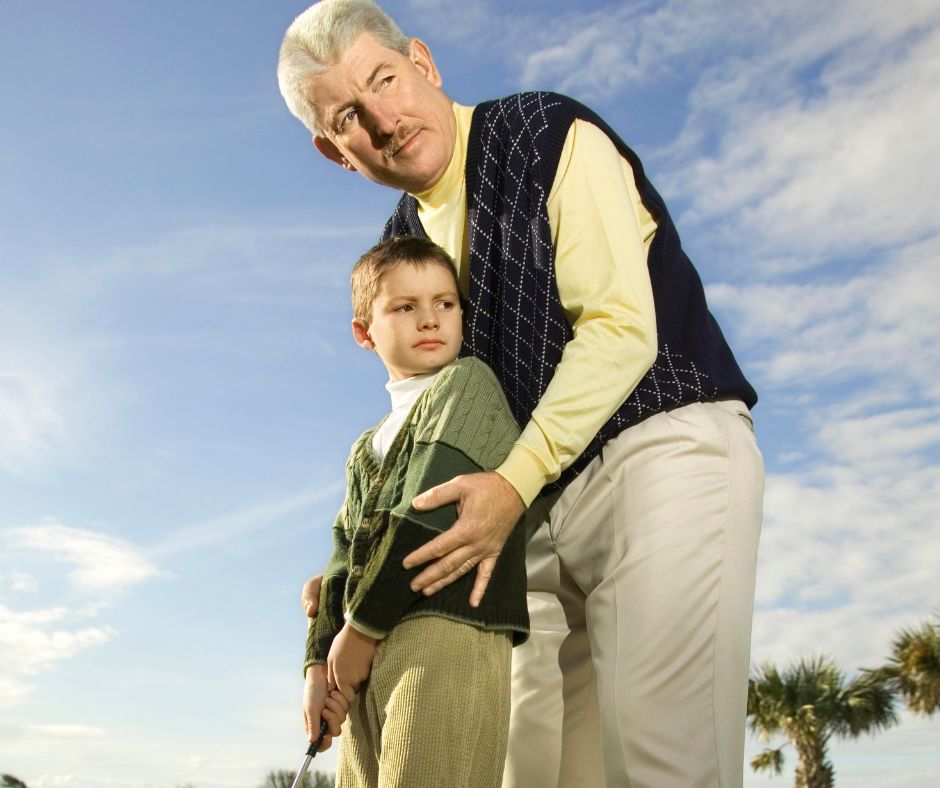Join Our Senior Golfers Newsletter!
Sign up today and receive your free Golf After 60 Bonus Stretch Guide!
Golf is more than just a sport; it’s a tradition, a way to connect generations, and an opportunity to impart valuable life lessons. As a grandparent, teaching golf to your grandchildren offers a unique chance to bond and create lasting memories, while also passing on valuable life skills and lessons. This extensive senior golfers guide will walk you through the process of introducing your grandchildren to the wonderful world of golf, offering tips, strategies, and insights to make the experience enjoyable and educational for both you and the young ones.
Estimated reading time: 11 minutes

Before diving into the technical aspects of teaching golf, it’s crucial to understand why this endeavor is so valuable:
• Intergenerational bonding: Golf provides a shared interest that can strengthen your relationship with your grandchildren.
• Physical activity: In an age of digital distractions, golf encourages outdoor exercise and physical coordination.
• Mental development: The game helps develop focus, strategy, and problem-solving skills.
• Character building: Golf’s emphasis on honesty, etiquette, and sportsmanship can instill important values.
• Lifelong skill: By introducing golf early, you’re giving your grandchildren a hobby they can enjoy throughout their lives.
Before stepping onto the course, it’s essential to introduce your grandchildren to the fundamental concepts of golf. Begin with simple explanations of the game’s objective, basic rules, and etiquette. Use age-appropriate language and relatable analogies to help them understand.
Key points to cover:
• The goal of getting the ball into the hole in as few strokes as possible
• The concept of different clubs for different shots (e.g., drivers for long distances, putters for on the green)
• Basic etiquette (being quiet when others are playing, respecting the course)
• Safety rules (never swinging a club near others, staying behind the person hitting)
• The layout of a golf course (tee box, fairway, rough, green, hazards)
• Scoring system (strokes, par, birdie, bogey, etc.)
Consider creating a simple, illustrated booklet or using online resources designed for junior golfers to reinforce these concepts.
“A kid grows up a lot faster on the golf course. Golf teaches you how to behave”
Jack Nicklaus
Remember that your primary goal is to instill a love for the game in your grandchildren. Focus on making the experience enjoyable rather than emphasizing perfect technique or scores.
Ideas to keep it fun:
• Use colorful, child-friendly golf equipment (oversized plastic clubs, foam balls for indoor practice)
• Incorporate games and challenges into practice sessions (target practice, longest drive contests)
• Create a points system that rewards effort and improvement, not just results
• Offer praise and encouragement frequently, celebrating small victories
• Keep sessions short to maintain interest (30-45 minutes for younger children, gradually increasing as they grow older)
• Use golf-themed coloring books or puzzles for downtime activities
• Watch exciting golf tournaments together, discussing the action and players
Putting is an excellent place to begin teaching golf skills. It’s easier for children to grasp and can be practiced in various settings, even at home or in the backyard.
Putting tips:
• Use a plastic cup or a hula hoop as a target for indoor or backyard practice
• Teach the basic pendulum motion of the putting stroke
• Emphasize the importance of a light grip and smooth motion
• Create fun putting games, like mini-golf courses in the backyard or living room
• Introduce the concept of reading greens by creating slopes with books or boards
• Practice distance control with games like “closest to the hole” or “putt to different targets”
Once your grandchildren have grasped putting, move on to chipping. This helps develop hand-eye coordination and introduces the concept of getting the ball airborne.
Chipping tips:
• Start with short distances and gradually increase
• Teach the importance of using different clubs for different distances and situations
• Incorporate target practice with hula hoops, buckets, or blankets with point zones
• Emphasize the similarities and differences between putting and chipping motions
• Introduce the concept of ball position and how it affects the chip shot
• Practice chipping over obstacles to make it more challenging and fun

Use colorful, child-friendly golf equipment (oversized plastic clubs, foam balls for indoor practice)
As your grandchildren become more comfortable with putting and chipping, introduce them to full swings. Start with shorter irons and progress to longer clubs.
Full swing tips:
• Begin with half-swings to develop proper technique and build confidence
• Use alignment sticks or clubs on the ground to help with stance and alignment
• Teach the basic grip, stance, and posture
• Focus on making solid contact rather than distance
• Introduce the concept of tempo and rhythm in the golf swing
• Use video analysis to show progress and areas for improvement
• Practice swings without a ball to focus on form before adding the challenge of hitting
Adapt your teaching style to suit your grandchildren’s ages, attention spans, and learning preferences. This personalized approach will help maintain their interest and optimize their learning.
For younger children (5-8 years):
• Use storytelling to explain concepts (e.g., “the club is like a magic wand that sends the ball flying”)
• Incorporate physical games that develop golf-related skills (e.g., throwing games for arm motion, balance exercises)
• Keep instructions simple and demonstrations short
• Use visual aids like colorful targets or animal-shaped obstacles
• Incorporate sing-along songs or rhymes to remember key points
For older children (9-12 years):
• Introduce more technical aspects of the swing (e.g., weight transfer, hip rotation)
• Explain the physics behind golf shots in simple terms (e.g., how club face angle affects ball flight)
• Encourage them to watch professional golf and discuss what they observe
• Introduce the concept of course management and decision-making
• Begin to incorporate more structured practice sessions with specific goals
For teenagers:
• Delve into more advanced techniques and strategy
• Discuss course management and decision-making in greater depth
• Encourage them to set goals and track their progress
• Introduce mental game concepts like visualization and pre-shot routines
• Explore the possibility of competitive play if they show interest
Golf safety and etiquette are crucial aspects of the game that should be instilled from the beginning. Make sure your grandchildren understand the importance of being aware of their surroundings and respecting other players.

Key safety and etiquette points:
• Always look around before swinging to ensure the area is clear
• Wait for the group ahead to be out of range before hitting
• Repair divots on the fairway and ball marks on the green
• Rake bunkers after use to leave them in good condition for the next player
• Maintain a reasonable pace of play to keep the course moving
• Respect other players by being quiet during their shots and not walking in their line on the green
• Properly care for the course (e.g., replacing divots, not driving carts where prohibited)
• Understand and follow local course rules and dress codes
Many young people are naturally drawn to technology. Incorporating golf-related apps and video analysis can enhance their learning experience and keep them engaged.
Technology tips:
• Use slow-motion video to analyze and improve swing technique
• Introduce golf simulation games for practice and fun (e.g., WGT Golf, Topgolf)
• Explore junior-friendly GPS apps for on-course distance information
• Watch instructional videos together and discuss the tips
• Use launch monitors or swing analyzers to provide data-driven feedback
• Create a shared online photo album or blog to document their golf journey
When your grandchildren are ready, introduce them to playing on an actual golf course. Start with par-3 courses or executive courses before progressing to full-length courses.
Course introduction tips:
• Begin with playing just a few holes to avoid fatigue and maintain interest
• Use forward tees or create temporary tees to make holes more manageable
• Focus on having fun rather than keeping score initially
• Teach them how to care for the course (fixing divots, ball marks, etc.)
• Introduce the concept of pace of play and how to keep up with the group ahead
• Gradually introduce scoring, but emphasize personal improvement over competition
• Discuss strategy and club selection for different situations on the course
“Golf, like the measles, should be caught young, for, if postponed to riper years, the results may be serious.“
PG Wodehouse
Many golf courses offer junior programs that can complement your teaching efforts. These programs provide structured learning environments and opportunities for your grandchildren to play with peers.
Benefits of junior programs:
• Professional instruction to supplement your teachings
• Interaction with other young golfers, fostering friendships and healthy competition
• Structured practice and play opportunities
• Potential for friendly competition and tournaments
• Exposure to different teaching styles and techniques
• Access to specialized junior golf equipment and facilities
• Opportunity to learn course management in a supervised setting
Learning golf takes time, and progress may be slow. It’s essential to remain patient and supportive throughout the process.
Tips for maintaining a positive atmosphere:
• Celebrate small victories and improvements, no matter how minor
• Avoid criticism and focus on constructive feedback
• Allow them to express frustration and help them work through it
• Share your own experiences of learning and improving in golf
• Set realistic expectations and goals together
• Emphasize effort and attitude over results
• Take breaks when needed and know when to end a session on a positive note

Creating Lasting Memories: Beyond the Game
Remember that teaching golf to your grandchildren is about more than just the sport. It’s an opportunity to create lasting memories and strengthen your bond.
Ideas for memorable golf experiences:
• Plan special golf outings or mini-tournaments with family members
• Create photo albums or scrapbooks of your golf journey together
• Establish traditions, like an annual grandparent-grandchild golf day
• Share stories of your own golf experiences and family history with the sport
• Attend professional golf tournaments together
• Design and create personalized golf accessories (e.g., ball markers, towels)
• Plan golf-themed vacations or visits to famous courses
Every child is different, so be prepared to adapt your teaching style to suit each grandchild’s personality, learning style, and physical abilities.
Adaptation strategies:
• For highly energetic children, incorporate more movement and quick-paced activities
• For analytical thinkers, explain the “why” behind techniques and strategies
• For visual learners, use more demonstrations and visual aids
• For auditory learners, use clear verbal instructions and golf-related songs or rhymes
• For kinesthetic learners, focus on feeling the correct movements and positions
• For children with physical limitations, explore adaptive golf equipment and techniques
• Adjust the pace of instruction to match each child’s learning speed and attention span
Golf is an excellent vehicle for teaching important life lessons. Use your time on the course to impart wisdom about patience, perseverance, honesty, and sportsmanship.
Life lessons to emphasize:
• The importance of practice and dedication in achieving goals
• How to handle success and disappointment gracefully
• The value of integrity (e.g., calling penalties on oneself)
• The benefits of setting and working towards long-term goals
• The importance of respect for others and the environment
• How to manage time and make strategic decisions
• The value of concentration and mental toughness
• The benefits of staying calm under pressure
As your grandchildren grow and develop their skills, it’s important to nurture their passion for golf and encourage continued engagement with the sport.
Strategies for long-term engagement:
• Help them set progressive goals as they improve
• Encourage participation in local junior golf tournaments or leagues
• Explore golf-related career paths or educational opportunities
• Introduce them to the broader golf community and industry
• Discuss the health benefits of golf as a lifelong activity
• Share articles, books, or documentaries about golf history and famous players
• Encourage them to volunteer at local golf events or mentor younger players

Golf books for younger golfers
We may earn a commission, at no additional cost to you.
Conclusion:
Teaching golf to your grandchildren is a journey filled with challenges, joys, and countless opportunities for bonding. By focusing on fun, starting with the basics, and adapting your approach to each child’s needs, you can help foster a lifelong love for the game. Remember that the most important aspect is the time spent together and the memories created, rather than perfecting technique or achieving low scores.
As you embark on this rewarding adventure, cherish the moments of laughter, learning, and shared excitement. Your passion for golf, combined with your love for your grandchildren, creates a powerful foundation for not only teaching the sport but also for strengthening family bonds and creating a legacy that spans generations.
Through patience, creativity, and a focus on enjoyment, you have the opportunity to introduce your grandchildren to a sport that can provide them with physical activity, mental challenges, and social connections throughout their lives. The lessons learned on the golf course – both about the game and about life – will stay with them long after the final putt drops.
By sharing your knowledge and love of golf, you’re not just teaching a sport; you’re passing down a tradition, imparting valuable life skills, and creating cherished memories that will last a lifetime. Your role as a grandparent and golf mentor has the potential to shape your grandchildren’s lives in profound and positive ways, extending far beyond the fairways and greens.




